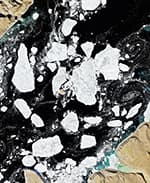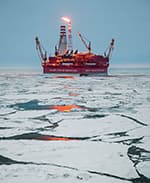- Polar politics and commerce
- > As a result of climate change, ice and cold in the polar regions are diminishing. This is particularly noticeable in the Arctic. Here shipping routes are opening up and mineral deposits are becoming accessible, arousing the attention of industry. In the Antarctic, too, ever more countries and companies are pursuing commercial interests. Here, however, the imperatives of environmental policy have kept commercial activities within bounds up to now.

Growing interest in the polar regions
Perceptions of the polar regions have changed fundamentally in recent decades. Once, these largely inaccessible regions mainly attracted seal hunters and whalers. Now, however, in the wake of climate change, there is growing international interest in exploring the Arctic and Antarctic and in tapping the potential of both polar regions for various forms of commercial exploitation. Consequently, membership of policy-making organizations is growing, along with the need for more regulation and consensus. Some traditional polar nations are adopting a more protectionist stance, making the process of reaching compromises more difficult in the Arctic and Antarctic alike.
In Antarctica, which is under the joint administration of the Consultative Parties, the principle guiding all activity is to preserve and protect the only region of the world dedicated to peaceful cooperation and research. The Antarctic Treaty and related environmental agreements restrict the use of Antarctica to research, sustainable and now strictly controlled fishing, and tourism.
The Arctic territories, by contrast, fall within the jurisdiction of the individual Arctic states. These states have a legitimate interest in promoting the economic development of the hitherto sparsely populated regions. Most Arctic nations, especially Russia, are now giving greater attention to resource extraction and shipping, for the Arctic is resource-rich: according to one study, the region north of the Arctic Circle holds approximately 22 per cent of the world’s undiscovered oil and natural gas. Large deposits of coal, iron ore, rare earths and other minerals are also to be found here. The extraction of these resources will become more lucrative in future as demand for them increases and the retreat of the ice opens up access to the northern regions.
However, the very substantial resource wealth has also led to territorial disputes among the Arctic coastal states. These disputes have smouldered for decades in some instances and are still only partially resolved. The bounty of the polar regions is also attracting interest from distant non-Arctic countries, notably China. Such countries are attempting to secure access rights and to have a say over the future of the Arctic by entering into bilateral agreements with Arctic states. Their strategies further involve investing in resource extraction and greatly increasing their engagement in the Arctic Council.
Resource extraction is accompanied by an increase in shipping in Arctic coastal waters. In the tourism sector, the cruise industry is also experiencing growth, with the number of ships and trips rising steadily. In order to minimise the attendant risk of maritime accidents, all vessels operating in polar waters must comply with the Polar Code, which prioritises prevention. Shipping in both polar regions is, as ever, a high-risk business due to the low temperatures and rapidly changing ice and weather conditions. If a vessel gets into difficulty, it can take a very long time for help to arrive, especially in the Antarctic.
A precautionary approach, combined with sustainability principles, must be the benchmark for these and all other areas of human activity in the polar regions. The Arctic and, indeed, some areas of Antarctica are radically changing due to climate change, and this puts great stress on local biotic communities and natural processes. Humankind must therefore do all it can to minimize its footprint in these highly fragile regions, not increase it through the reckless pursuit of profits.

